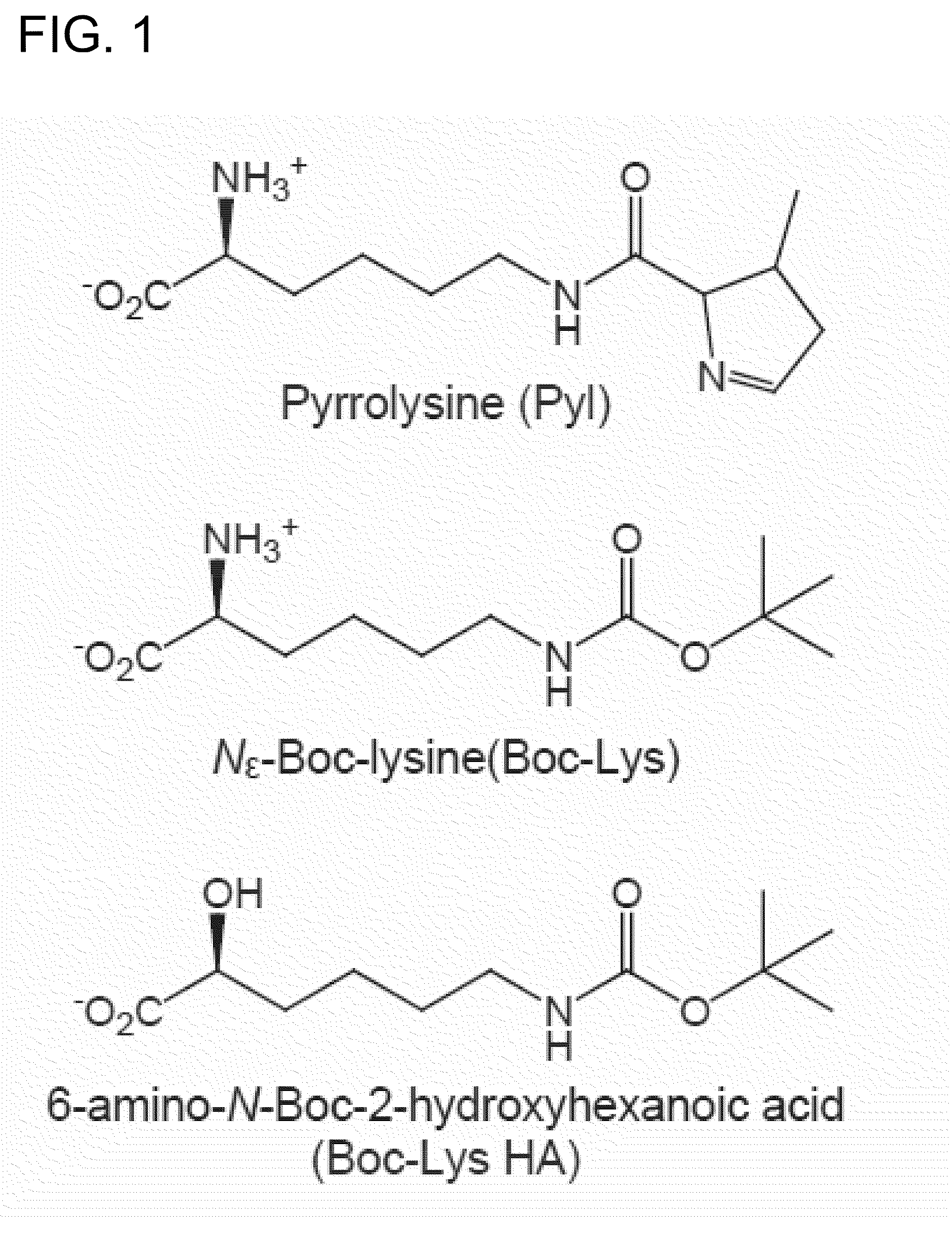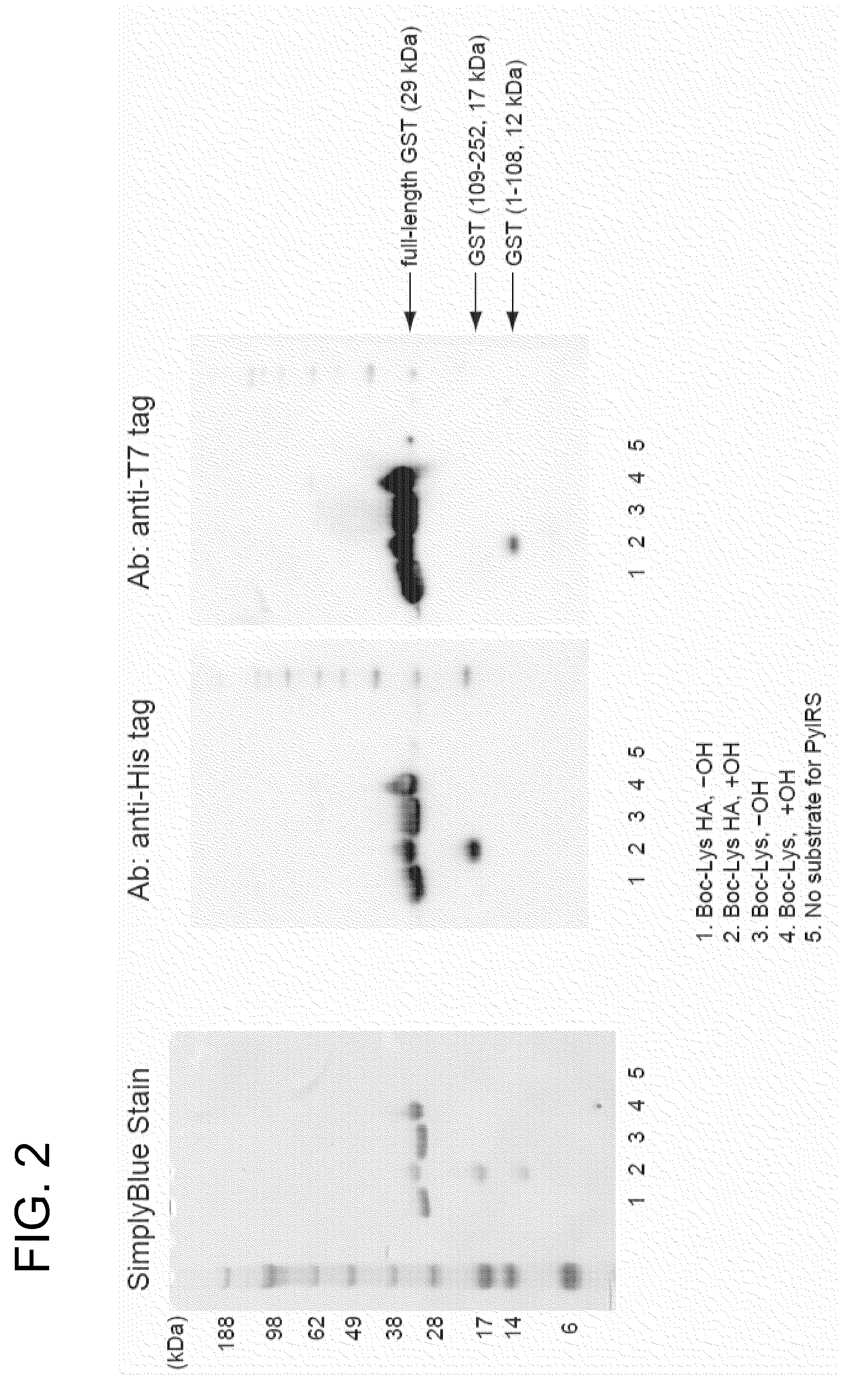Process for production of non-natural protein having ester bond therein
a technology of non-natural protein and ester bond, which is applied in the field of process for producing non-natural protein having ester bond, can solve the problems of inability to reuse trna itself, inability to achieve a single-unit translation system, etc., and achieves the effect of easy cleavag
- Summary
- Abstract
- Description
- Claims
- Application Information
AI Technical Summary
Benefits of technology
Problems solved by technology
Method used
Image
Examples
example 1
Synthesis of the Non-Natural Protein Incorporating the α-Hydroxy Acid Using E. Coli Cell
[0056](1) Synthesis of α-Hydroxy Acid Boc-Lys-HA
[0057]H-Lys (Boc)-OH (Bachem) as a raw material, it is organically synthesized based on a method of a reference (Organic Letters 6, 497-500 (2004)).
[0058](2) Plasmid
[0059](2.1) PylRS / tRNAPyl Expression System
[0060]The full-length PylRS gene was expressed under controlling of E. coli trpS promoter in plasmid pTK2-1. This plasmid pTK2-1 is a derivative of a plasmid pACYC184, and in which plasmid, one copy of tRNAPyl gene is expressed under the controlling of kanamycin resistant gene and E. coli 1 pp promoter.
[0061](2.2) Glutathione-5-transferase (GST) Expression System Incorporating an Ester Bond
[0062]The glutathione-5-transferase (GST) gene in which a cysteine codon at 109 position from N terminal was mutated to amber codon (TAG) was cloned between NdeI-BamHI sites in pET21b (ampicillin resistance), and an expression vector such that the following pr...
example 2
[0076]Introduction of Boc-Lys-HA into Protein for HEK293c-18 Strain
[0077](1) Cell which was Used
[0078]HEK293c-18 Strain (ATCC No. CRL-10852)
[0079](2) Plasmid
[0080]A leucine codon at 111 position in human grb2 was converted to an amber codon (grb2 (Am111)) by using Quick Change site-directed mutagenesis kit (Stratagene). Then, a gene (SEQ ID NO:7) which was constructed such that FLAG tag (DYKDDDDK) is added to C-terminal was incorporated into BamHI-XhoI site in pOriP vector, and this resultant was defined as a plasmid for detecting suppression. The Grb2 is a protein that is related to cell canceration, interacting with epidermal growth factor receptor within a cell.
[0081]A construction of PylRS expression plasmid was performed such that the wild-type PylRS gene DNA sequence (SEQ ID NO:1) derived from Methanosarcina mazei was amplified by using PCR method. This amplified product was incorporated into NheI-BamHI site in pOriP vector, to construct a plasmid.
[0082]For an expression vecto...
PUM
| Property | Measurement | Unit |
|---|---|---|
| temperature | aaaaa | aaaaa |
| structure | aaaaa | aaaaa |
| permeability | aaaaa | aaaaa |
Abstract
Description
Claims
Application Information
 Login to View More
Login to View More - R&D
- Intellectual Property
- Life Sciences
- Materials
- Tech Scout
- Unparalleled Data Quality
- Higher Quality Content
- 60% Fewer Hallucinations
Browse by: Latest US Patents, China's latest patents, Technical Efficacy Thesaurus, Application Domain, Technology Topic, Popular Technical Reports.
© 2025 PatSnap. All rights reserved.Legal|Privacy policy|Modern Slavery Act Transparency Statement|Sitemap|About US| Contact US: help@patsnap.com



